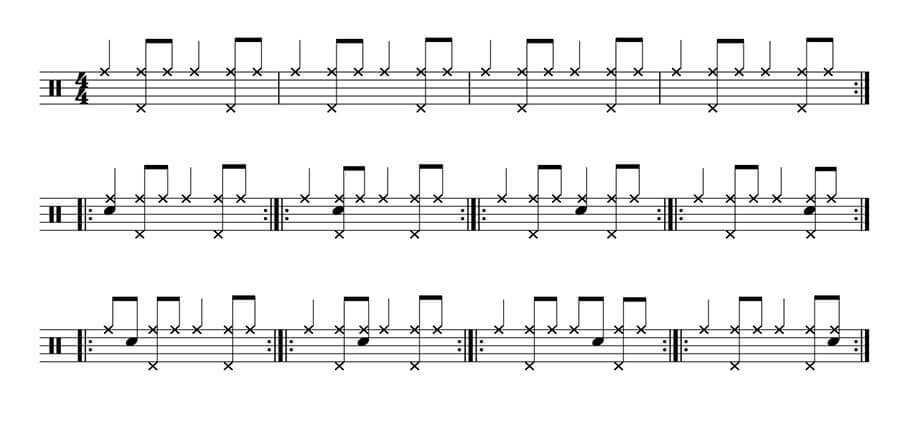© All rights reserved Copyright 2024
Learn How To Play Jazz Drums
Drum Beats
INTROduction:
Jazz is one of the most exciting and expressive styles of drumming so it’s definitely worth studying at some point in your evolution. It will expand your musicianship and give you the vocabulary you need to be a more dynamic and creative drummer.
Most of today’s top drummers (Steve Smith, Dave Weckl, Vinnie Colaiuta) have a strong foundation in jazz and even a little time spent working on this style will work wonders for your playing.
So grab you drum set. In this lesson will show you the basics of jazz which you can then build on and take in whichever direction you like.
The Basic Groove
The main pulse of jazz is the quarter note with an underlying 8th note triplet feel. Play four quarter notes on the ride cymbal with a “skip” note on the third note of the triplet of beats 2 and 4. Count and play “1, 2 and, 3, 4 and” with the quarter notes at the same volume and the “skip” note unaccented. Once you have this going pedal the hi-hat on 2 and 4 to create the basic jazz pattern.
Practice this groove at a slow 50bpm to really lock in the timing and work on getting the right sound.
You’ll notice in the transcription below that the rhythms are written as straight eighth notes. This is often the case with jazz but they should still be interpreted and played with a swung triplet feel.

Comping Basics
Once you are comfortable with the basic jazz pattern the next step is to work on comping. This means to accompany and compliment the music with your drumming. It helps to enhance the feel of the music and create a dynamic conversation between you and the other players.
Comping involves playing little patterns on the snare and bass drum which support and drive the music. It requires good interdependence between your limbs, a good ear and responsiveness to what’s going on around you.
The video and the transcription demonstrate basic eighth note comping ideas. Watch the video then practice these patterns to a click at a slow to moderate tempo. Try to keep the ride/hi-hat groove consistent throughout. Play each bar at least thirty two times before moving on to the next. When it’s grooving repeat the exercise comping with the bass drum.
Improvisation Basics
Once you are comfortable and have a good sound with the comping examples, you will want to learn how to improvise with them. The next exercise will help you to develop that freedom along with your jazz sensibility.
Play four bars of time followed by four bars of comping with a variety of patterns on the snare and bass. Mix and match the patterns to create interesting little motifs – play something with the snare then repeat it on the bass – sing a melody in your head then try to comp it.
Play along with a metronome as before and also along to some jazz records – you will hear what all the other musicians are doing and pick up some tasty ideas. Can you compliment what’s happening in the music?
Listening
So, now you’ve got the basics of jazz drumming down it’s time to go and get the earphones on. The only way to truly learn a style is by immersing yourself in it and the best way to do that is by listening to the music often. Frequent exposure will help your ears adjust to the “language” of jazz and it will slowly absorb into your subconsciousness.
There are many, many great jazz records and jazz drummers that you will want to check out eventually so here are three albums to get you started on your journey: Milestones by Miles Davis, Monk’s Dream by Thelonius Monk and Moanin’ by Art Blakey And The Jazz Messengers.
There are also three great jazz instructional products that will help take your jazz playing to the next level. The Art of Bop Drumming by John Riley, Progressive Independence by Ron Spagnardi and The Jazz Drumming System by Mike Michalcow. I’ve benefited a lot from these materials and recommend them highly.
If you have any questions or personal experiences with jazz then please share your thoughts in the comments below.
Good luck and make it swing! DN

